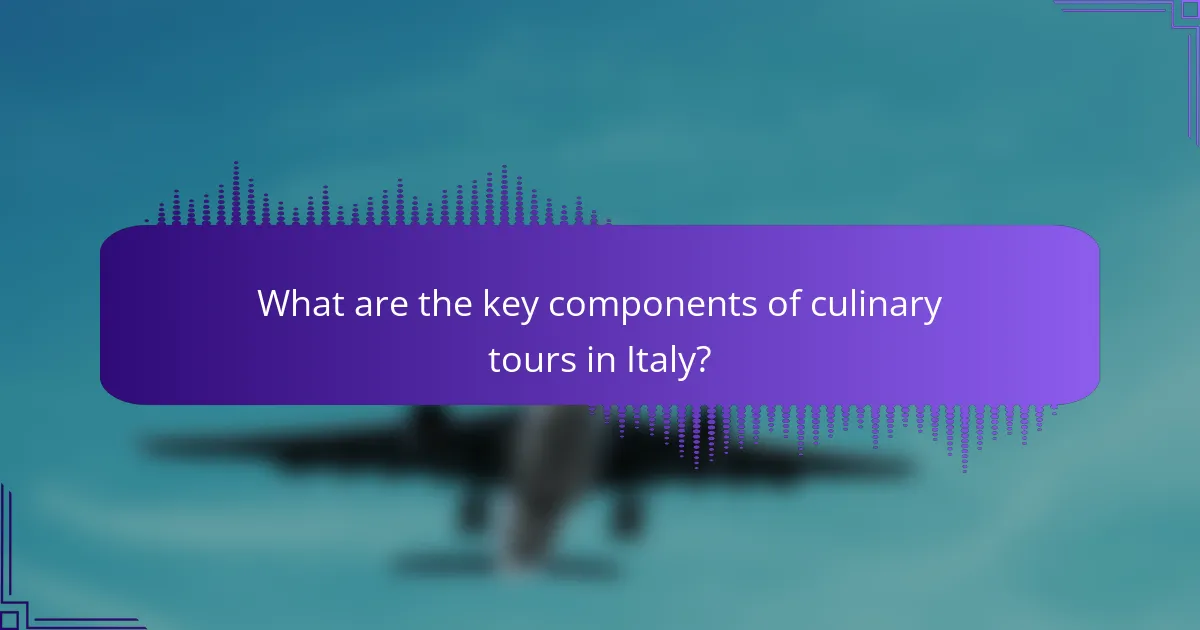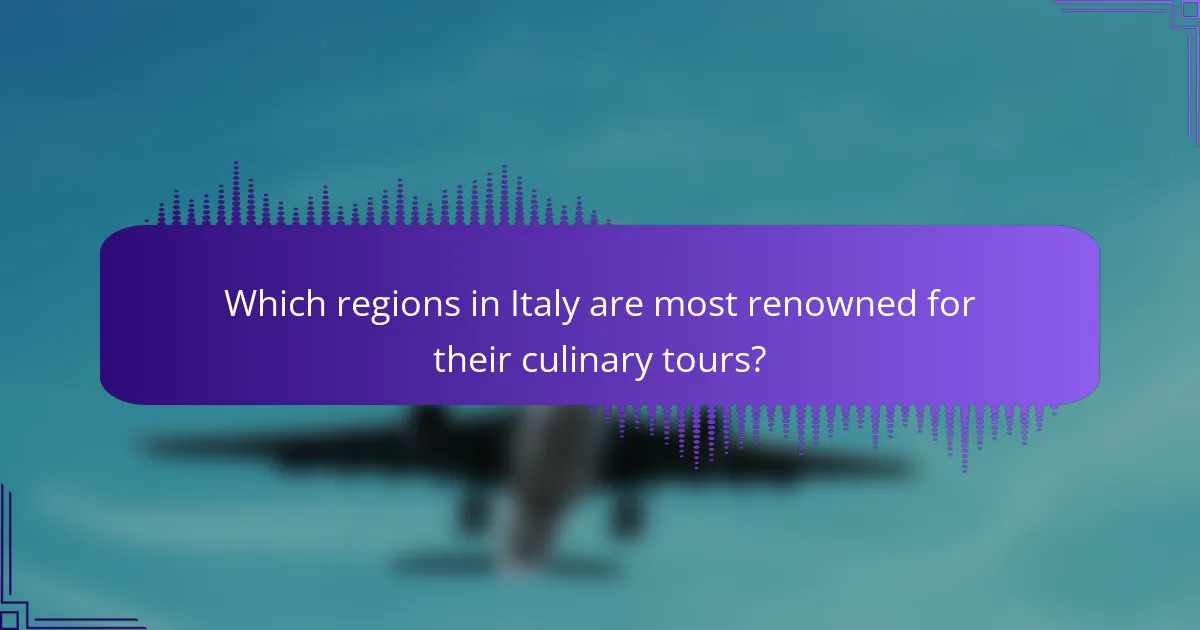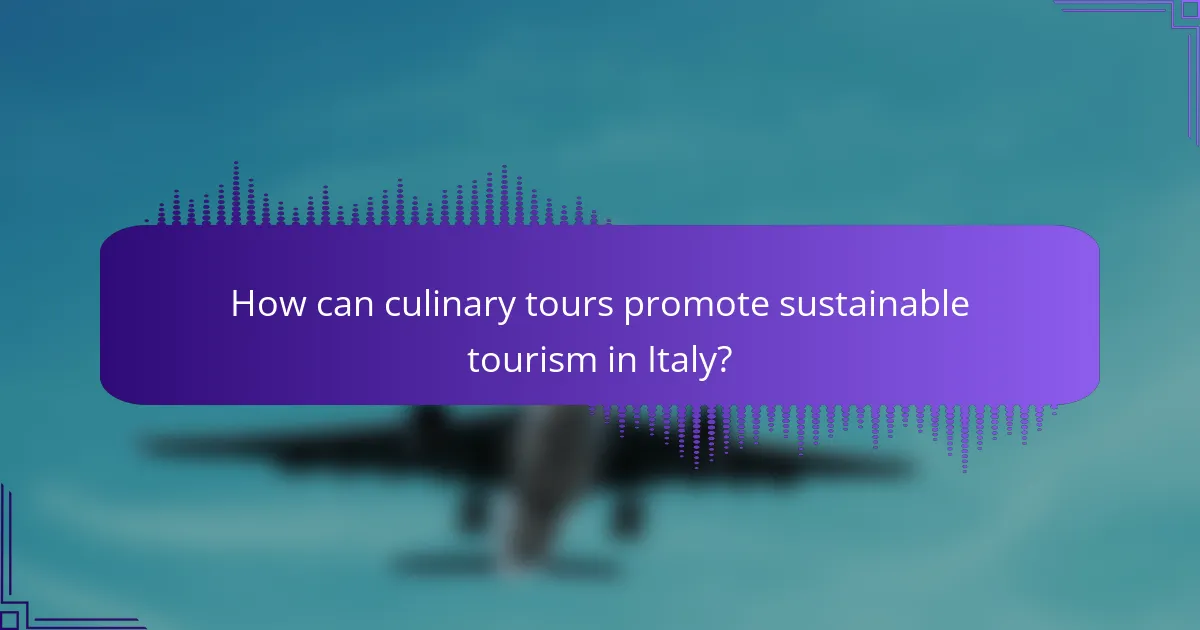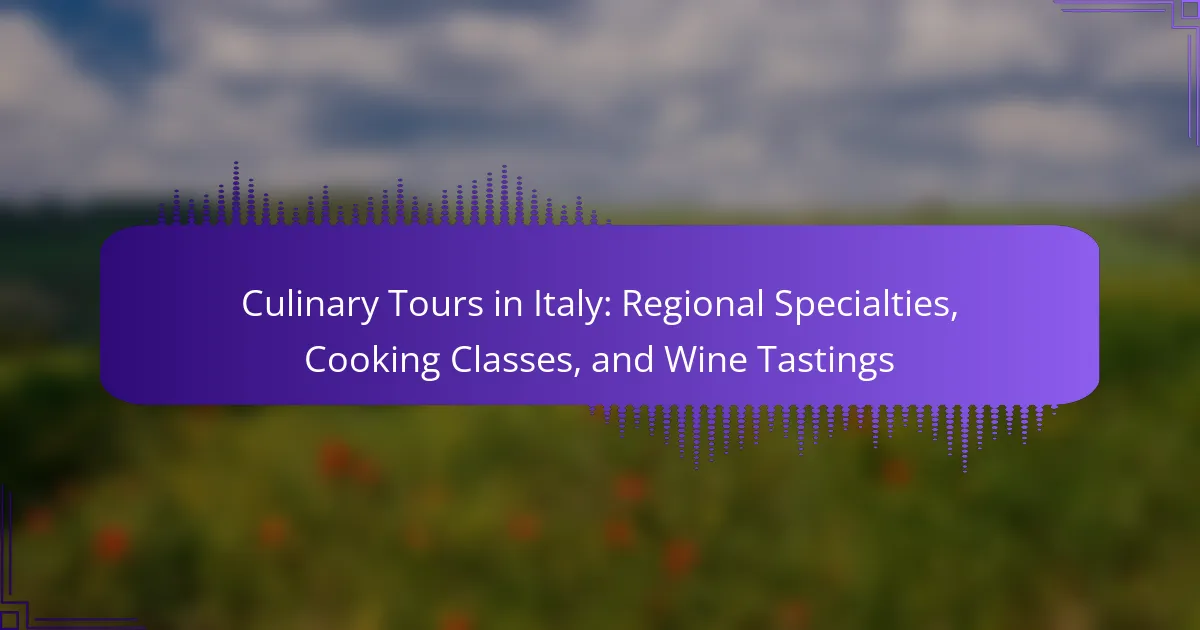Experience the rich flavours of Italy through culinary tours that offer regional specialities, hands-on cooking classes, and wine tastings. Explore unique dishes from Tuscany, Emilia-Romagna, and Sicily while learning authentic recipes from local chefs. Discover the art of pairing food with wines from diverse regions, enhancing your appreciation for Italy’s gastronomic heritage. Engage in immersive experiences that connect you with local traditions and sustainable practices.

What are the key components of culinary tours in Italy?
Culinary tours in Italy feature key components such as regional specialities, hands-on cooking classes, and wine tastings. These elements enhance the experience by showcasing local ingredients and traditions.
Regional specialities highlight unique dishes from various areas, such as Neapolitan pizza and Tuscan ribollita. Cooking classes allow participants to learn authentic recipes and techniques from local chefs. Wine tastings introduce travellers to Italy’s diverse wine regions, offering insight into the pairing of food and wine.
These components create an immersive culinary adventure, connecting visitors with Italy’s rich gastronomic heritage.
How do regional specialities influence culinary tours?
Regional specialities significantly enhance culinary tours by offering authentic local flavours and unique cultural experiences. Each region in Italy boasts distinct ingredients and traditional recipes, making the culinary journey diverse and enriching. For example, Tuscany is renowned for its olive oil and Chianti wine, while Sicily features fresh seafood and citrus fruits. Cooking classes often focus on these regional specialities, allowing participants to learn and recreate traditional dishes. Wine tastings further complement this experience, showcasing local varietals that reflect the terroir. Overall, regional specialities are essential in shaping memorable culinary tours in Italy.
What role do cooking classes play in enhancing the culinary experience?
Cooking classes significantly enhance the culinary experience by providing hands-on learning and cultural immersion. Participants gain practical skills, learn regional cooking techniques, and discover local ingredients, enriching their understanding of Italian cuisine. These classes often incorporate wine tastings, allowing for a comprehensive exploration of food and drink pairings. Engaging with local chefs fosters a deeper appreciation for traditional recipes and culinary heritage. Ultimately, cooking classes transform meals into memorable experiences, connecting participants with Italy’s rich gastronomic culture.
Why are wine tastings essential to Italian culinary tours?
Wine tastings are essential to Italian culinary tours because they enhance the overall gastronomic experience. They allow participants to explore regional wines, pairing them with local dishes. This immersion deepens appreciation for Italy’s diverse wine culture and traditions. Additionally, wine tastings often include expert guidance, providing insights into the winemaking process and the unique attributes of each wine. Engaging in this activity elevates the culinary tour, making it a memorable journey through Italy’s rich flavours.

Which regions in Italy are most renowned for their culinary tours?
Regions in Italy renowned for culinary tours include Tuscany, Emilia-Romagna, and Sicily. Each region offers unique specialities, cooking classes, and wine tastings that highlight local traditions.
Tuscany is famous for its olive oil and wine, making it a top choice for food enthusiasts. Emilia-Romagna is celebrated for its rich pasta dishes and balsamic vinegar, attracting culinary tourists seeking authentic Italian cuisine. Sicily offers a diverse array of flavours influenced by its history, featuring seafood and sweet pastries.
These regions provide immersive experiences, allowing participants to learn from local chefs and explore markets. Culinary tours in Italy not only showcase regional specialities but also foster a deeper appreciation for the country’s rich gastronomic heritage.
What unique dishes can be found in Northern Italy?
Northern Italy offers unique dishes such as Risotto alla Milanese, Tortellini di Bologna, and Polenta. These specialities reflect regional ingredients and culinary traditions, making them essential for culinary tours.
Risotto alla Milanese features saffron, giving it a distinct golden colour. Tortellini di Bologna are stuffed pasta, often filled with a mix of meats and cheese. Polenta, a cornmeal dish, varies in preparation and can be served soft or grilled.
Exploring these dishes through cooking classes enhances the experience, allowing participants to learn traditional techniques. Wine tastings complement these meals, showcasing local varieties like Barolo and Prosecco, enriching the culinary journey in Northern Italy.
How does Southern Italy’s cuisine differ in culinary tours?
Southern Italy’s cuisine offers distinct flavours and dishes compared to other regions, highlighting local ingredients and traditions. Culinary tours in this area focus on fresh seafood, citrus fruits, and unique pasta varieties like orecchiette. Cooking classes often emphasize traditional techniques, while wine tastings showcase regional wines such as Primitivo and Nero d’Avola. The emphasis on local produce and family recipes creates a rich, immersive experience for participants.
What specialities are associated with Central Italy?
Central Italy is renowned for its rich culinary specialities, including pasta dishes, cheeses, and wines. Key regional specialities include Roman-style pasta, such as Carbonara and Cacio e Pepe, as well as the famous Porchetta from Ariccia. Tuscany offers robust wines like Chianti and unique dishes such as Ribollita, a hearty vegetable soup. Additionally, the region is known for its artisanal cheeses, including Pecorino Romano. Culinary tours often highlight these specialities through cooking classes and wine tastings, providing an immersive experience into Central Italy’s gastronomic culture.

How do cooking classes vary across different regions?
Cooking classes vary significantly across regions in Italy, reflecting local ingredients and culinary traditions. Each region emphasizes unique dishes and techniques, making the learning experience diverse.
In Tuscany, classes often focus on rustic, farm-to-table cooking, highlighting fresh produce and traditional recipes. Participants learn to make pasta and sauces using local olive oil and wines.
In Emilia-Romagna, classes centre on the art of pasta-making, particularly tortellini and lasagna, paired with regional wines. The emphasis is on the balance of flavours and the importance of quality ingredients.
Southern Italy, especially in Campania, showcases vibrant flavours with a focus on seafood and tomato-based dishes. Cooking classes here often include pizza-making, emphasizing the use of fresh herbs and local cheeses.
Overall, culinary classes in Italy offer a rich tapestry of regional specialities, allowing participants to immerse themselves in the country’s diverse food culture.
Which cooking techniques are emphasized in traditional Italian classes?
Traditional Italian cooking classes emphasize techniques such as pasta making, risotto preparation, and sauce crafting. These methods highlight regional specialities and authentic flavours. Participants learn to master skills like kneading dough, sautéing, and balancing seasonings, which are essential to Italian cuisine. Classes often focus on using fresh, local ingredients to create traditional dishes, enhancing the overall culinary experience.
What are the benefits of hands-on cooking experiences for tourists?
Hands-on cooking experiences for tourists offer immersive cultural engagement, skill development, and memorable culinary enjoyment. Participants learn authentic regional recipes, enhancing their appreciation for local cuisine. These classes often include wine tastings, enriching the overall gastronomic experience. Additionally, tourists gain confidence in cooking techniques, fostering a deeper connection to Italian culture.

What are the best practices for selecting a culinary tour in Italy?
To select the best culinary tour in Italy, prioritise experiences that emphasize local specialities, cooking classes, and wine tastings. Look for tours that feature authentic regional cuisine, skilled chefs, and opportunities for hands-on learning.
Consider the following factors when making your decision:
1. **Region**: Different areas offer unique culinary traditions, such as pasta in Emilia-Romagna or seafood in Sicily.
2. **Class Size**: Smaller groups enhance the experience, allowing for personalized instruction and interaction.
3. **Duration**: Select a tour that fits your schedule, ranging from half-day classes to week-long experiences.
4. **Reviews**: Research feedback from previous participants to gauge the quality and authenticity of the tour.
5. **Inclusions**: Check what is included, such as meals, transportation, and wine tastings, to ensure value for money.
Choosing a culinary tour that aligns with these criteria will enhance your Italian gastronomic adventure.
How can travellers evaluate the quality of culinary tours?
Travellers can evaluate the quality of culinary tours by considering factors such as authenticity, expert guides, and participant reviews. Authenticity ensures that the tour showcases local cuisine and traditions. Expert guides enhance the experience with in-depth knowledge of regional specialities. Participant reviews provide insights into the overall satisfaction and value of the tour. Additionally, comparing the variety of activities, such as cooking classes and wine tastings, can reveal the tour’s comprehensiveness. Quality culinary tours often feature unique regional dishes and immersive experiences that highlight local culture.
What should participants expect from a typical culinary tour itinerary?
Participants can expect a diverse culinary experience highlighting regional specialities, hands-on cooking classes, and engaging wine tastings. Itineraries typically include visits to local markets, guided tours of historic food sites, and opportunities to interact with chefs. Cooking classes focus on authentic recipes, while wine tastings showcase local vineyards and varietals. Each day offers a blend of cultural immersion and culinary education, ensuring a memorable journey through Italy’s rich gastronomic landscape.

Which culinary events or festivals enhance the tour experience?
Culinary festivals and events significantly enhance the tour experience in Italy. Events like the Alba White Truffle Festival showcase local delicacies, while the Sagra del Tartufo in Umbria focuses on truffles. Additionally, the Vinitaly wine exhibition highlights regional wines, offering tastings and workshops. Cooking classes at these events allow participants to learn traditional recipes, deepening their culinary knowledge. Engaging with local chefs and artisans creates memorable experiences, emphasizing the unique attributes of Italian cuisine.
How do seasonal events impact culinary offerings in Italy?
Seasonal events significantly enhance culinary offerings in Italy by showcasing regional specialities. Each season brings unique ingredients and traditional dishes that reflect local culture and agricultural cycles. For example, spring features artichokes and asparagus, while autumn highlights truffles and chestnuts. Culinary tours capitalize on these seasonal changes, offering cooking classes and wine tastings that emphasize fresh, local produce. This connection between seasons and cuisine enriches the overall experience for visitors seeking authentic Italian flavours.
What are the most popular food festivals to attend during tours?
Italy hosts numerous popular food festivals that enhance culinary tours. Notable events include the Alba White Truffle Festival, celebrating truffle hunting and tasting, and the Sagra del Tartufo in Umbria, focusing on local truffle dishes. The Vinitaly in Verona showcases Italy’s finest wines, while the Fiera di San Martino in Tuscany highlights regional specialities. The Cheese Festival in Bra features artisanal cheeses and workshops. Each festival offers unique insights into Italy’s rich culinary heritage and local flavours.

How can culinary tours promote sustainable tourism in Italy?
Culinary tours promote sustainable tourism in Italy by connecting travellers with local producers and traditions. These tours highlight regional specialities, fostering appreciation for local cuisine and culture. Participants often engage in cooking classes and wine tastings, which support small businesses and encourage responsible consumption. As a result, culinary tourism helps preserve culinary heritage while promoting environmental awareness.
What practices can enhance the sustainability of culinary experiences?
Culinary experiences can enhance sustainability through local sourcing, waste reduction, and community engagement. Prioritising regional ingredients reduces transportation emissions and supports local farmers. Implementing waste management practices, such as composting and recycling, minimizes environmental impact. Engaging with local communities fosters cultural exchange and promotes traditional cooking techniques, preserving culinary heritage while ensuring sustainability in tourism.
How do local producers contribute to culinary tours?
Local producers enhance culinary tours by offering authentic regional flavours and experiences. They provide fresh ingredients, share traditional cooking techniques, and offer insights into local food culture. Engaging with local producers allows participants to learn about the origin of dishes and the significance of specific ingredients, enriching the overall culinary experience. This direct connection fosters appreciation for local customs and sustainable practices, making culinary tours more immersive and educational.

What common mistakes should travellers avoid when booking culinary tours?
Travellers should avoid common mistakes like neglecting research, overlooking regional specialities, and not considering class sizes.
Firstly, failing to research culinary tours can lead to missed opportunities for authentic experiences. Secondly, many travellers ignore regional specialities, which are crucial for a genuine Italian culinary experience. Lastly, not checking class sizes can result in overcrowded sessions, reducing personal attention during cooking classes.
How can tourists ensure they are getting authentic experiences?
Tourists can ensure authentic experiences by choosing local culinary tours that emphasize regional specialities and traditional cooking methods. Engaging in cooking classes with local chefs enhances cultural immersion. Participating in wine tastings at vineyards allows tourists to appreciate local varieties and practices. Seeking tours led by locals ensures insights into hidden gems and authentic flavours. Reading reviews and seeking recommendations from previous participants can also guide tourists toward genuine experiences.
What are the pitfalls of choosing budget culinary tours?
Choosing budget culinary tours can lead to several pitfalls. These tours often prioritize low costs over quality, resulting in subpar experiences. Common issues include limited access to authentic regional specialities, inadequate cooking class instruction, and less knowledgeable guides. Additionally, budget tours may skimp on wine tastings, offering lower-quality selections. Travellers might miss out on immersive cultural experiences due to rushed itineraries. Lastly, hidden fees can inflate overall costs, negating initial savings.
What expert tips can enhance the culinary tour experience?
To enhance your culinary tour experience in Italy, focus on engaging with local chefs, participating in hands-on cooking classes, and exploring regional markets. These activities provide authentic insights into Italian cuisine.
Consider these expert tips:
1. Research regional specialities before your trip to tailor your culinary experiences.
2. Book cooking classes in advance to secure spots with renowned chefs.
3. Visit local markets to discover fresh ingredients and interact with vendors.
4. Pair your meals with wine tastings to deepen your understanding of regional pairings.
These strategies will enrich your culinary journey, allowing you to savour Italy’s diverse flavours.
